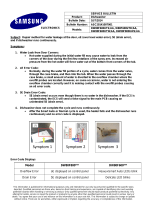
18
EN
OPERATION
Operation Overview
Using the Appliance
Before the first wash, select the Cotton wash
programme and add a half amount of the detergent.
Start the appliance without laundry. This will remove
possible residues and water from the drum that may
have been left during manufacturing.
1
Sort laundry and load items.
• Sort laundry by fabric type, soil level, colour
and load size as needed. Open the door and
load items into the appliance.
2
Add detergent or softener.
• Add the proper amount of detergent to the
detergent dispenser drawer. If desired, add
bleach or fabric softener to the appropriate
areas of the dispenser.
3
Turn on the appliance.
• Press the Power button to turn on the
appliance.
4
Choose the desired cycle.
• Press the cycle button repeatedly or turn the
cycle selector knob until the desired cycle is
selected.
• Now select a wash temperature and spin
speed. Pay attention to the care labeling of
your clothes.
5
Begin cycle.
• Press the Start/Pause button to begin the
cycle. The appliance will agitate briefly
without water to measure the weight of the
load. If the Start/Pause button is not pressed
within 15 minutes, the appliance will shut off
and all settings will be lost.
6
End of cycle.
• When the cycle is finished, a melody will
sound. Immediately remove your clothing
from the appliance to reduce wrinkling.
Check around the door seal when removing
the load for small items that may be caught
in the seal.
Preparing the Wash Load
Sort laundry for best washing results, and then
prepare laundry according to the symbols on the
care labels.
Sorting the Wash Load
• For best washing results, sort your clothes
according to the symbol on the care labels
according to the type of fabric and washing
temperature and wash them with adapted spin
speed.
• Soil (Heavy, Normal, Light): Separate clothes
according to amount of soil.
• Colour (White, Lights, Darks): Separate white
fabrics from coloured fabrics. Wash new dark
and colored garments separately at first.
• Lint (Lint producers, Collectors): Wash lint
producers and lint collectors separately.
Checking the Clothes Care Label
Symbols on the care labels
The symbols tell you about the fabric content of
your garment and how it should be washed.
Symbol Wash / Fabric type
• Normal Wash
• Cotton, Mixed Fabrics
• Easy Care
• Synthetic, Mixed Fabrics
• Special Delicate Wash
• Delicates
• Hand Wash Only
• Wool, Silk
• Do not wash
NOTE
• The dashes under the symbol give you
information about the type of fabric and the
maximum allowance of mechanical stress.




















